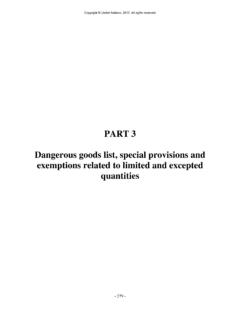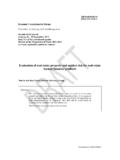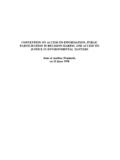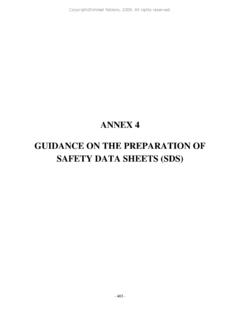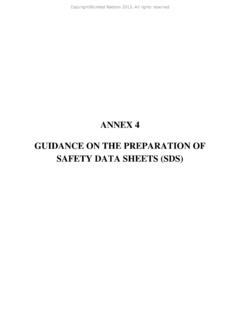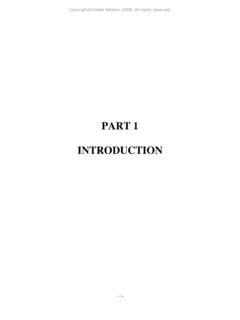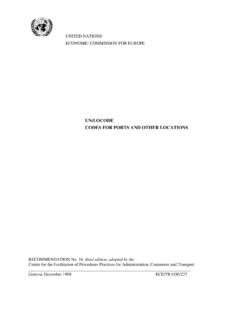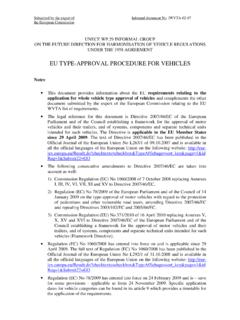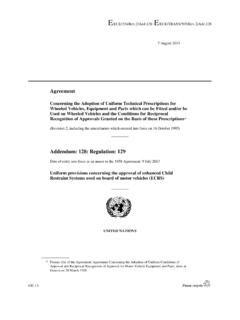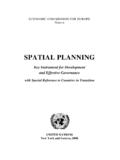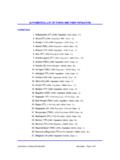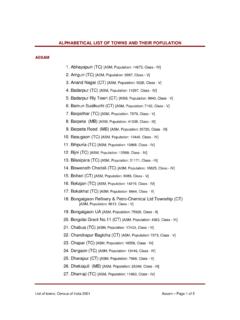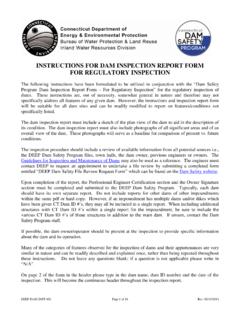Transcription of UN/LOCODE CODES FOR PORTS AND OTHER …
1 UNITED NATIONS ECONOMIC COMMISSION FOR EUROPE UN/LOCODE CODES FOR PORTS AND OTHER locations RECOMMENDATION No. 16, third edition, adopted by the Centre for the Facilitation of Procedures Practices for Administration, Commerce and Transport _____ Geneva, December 1998 ECE/TRADE/227 ECE/TRADE/227 Page 2 Recommendation No. 16 UN/LOCODE - code FOR PORTS AND OTHER locations The work to prepare CODES , for PORTS commenced in 1972, when the UN/ECE Working Party on Facilitation of International Trade Procedures agreed to include this task in its programme of work, later on specified as follows: "to establish the need to designate various locations involved in external trade (cities, PORTS , airports, border crossings, terminals, etc.)
2 With a view to the subsequent creation of CODES ". After consultation with OTHER regional United Nations commissions (ECLAC and ESCAP) and with the International Air Transport Association (IATA), a programme of action for the development of a code was agreed in September 1977. As a result, a draft Recommendation was submitted to the Working Party on Facilitation of International Trade Procedures and adopted at its twelfth session in September 1980. The Working Party, at its forty-second session in September 1995, approved a second edition of Recommendation No. 16, based on secretariat proposals for amendments and including an Annex containing the UN/LOCODE Manual. As a result of re-engineering its structures and work in order to become more efficient and effective, in March of 1997 the Working Party on Facilitation of International Trade Procedures became the Centre for the Facilitation of Procedures and Practices for Administration, Commerce and Transport (UN/CEFACT).
3 Based on proposals put forward by an Ad Hoc Group of Experts, UN/CEFACT, at its fourth session in September 1998, adopted the third edition of Recommendation No. 16. At its fourth CEFACT Session in September 1998, representatives attended from the following countries: Australia, Austria, Belgium, Brazil, Bulgaria, Canada, Czech Republic, Denmark, Finland, France, Germany, Hungary, Iran (Islamic Republic of), Ireland, Italy, Japan, Luxembourg, the Netherlands, Nigeria, Poland, Republic of Korea, Romania, Russian Federation, Slovakia, Slovenia, Spain, Sweden, Tunisia, Turkey, United Kingdom of Great Britain and Northern Ireland and United States of America. The European Union (EU), the following inter-governmental organizations : Bank for International Settlements (BIS) and the World Trade Organization (WTO).
4 , the following United Nations bodies: The United Nations Conference on Trade and Development (UNCTAD) and the International Telecommunications Union (ITU), the following non-governmental organizations :European Electronic Messaging Association (EEMA), International Article Numbering Association (EAN) International Association of PORTS and Harbours (IAPH), International Organization for Standardization (ISO), Soci t Internationale de T l communications A ronautiques (SITA), Society for Worldwide Interbank Financial Telecommunications ( ) and the United Towns Agency for North-South Cooperation., and as Observers: representatives from the Association of Committees on Simplified Procedures for International Trade within the European Community and the European Free Trade Association (EUROPRO), Electronic Commerce Europe Association (ECEA), European Board for EDI/EC Standardization (EBES), International Federation of Inspection Agencies (IFIA), Taipei EDIFACT Committee (TEC).
5 RECOMMENDATION The Centre for the Facilitation of Procedures and Practices for Administration Commerce and Transport (UN/CEFACT), Being aware of the need for an intemationally agreed code system to represent names of certain locations of interest in international trade and transport; Considering that the code system should be based on the two-letter alphabetic CODES for the representation of names of countries, adopted in International Standard ISO 3166 and recommended by the Working Party in October 1974; Recommends that the five-character code system described hereafter should be used for purposes of trade to designate locations whenever there is a need for a coded representation for the names of PORTS , airports, inland clearance depots, inland freight terminals and OTHER transport related locations , such as places of receipt and delivery, which are used for goods movements associated with trade (for example locations where Customs clearance of goods can take place), or otherwise proposed by Governments; Invites Governments to transmit lists of entities with code designations according to the established criteria and to ensure that each national list is continuously updated and communicated to the United Nations secretariat, responsible for the maintenance of the code system.
6 I. BACKGROUND 1. The identification of a particular location is frequently required in information interchange in international trade and transport, to direct the movement of goods, in addresses, in shipping marks, and in data elements identifying PORTS of call, PORTS or places of loading or unloading, PORTS or places of transhipment and destination, places of clearance by Customs, etc. ECE/TRADE/227 Page 3 2. The names of such locations are often spelt in different ways and sometimes the same location is given different names in different languages ( LIVORNO - LIBOURNE - LEGHORN; LONDON - LONDRES - LONDRA; WARZSAW - VARSOVIE - WARSZAWA - WARSCHAU), which creates confusion and difficulties in data interchange. The identification in a unique and unambiguous way of any place involved in international trade is therefore an essential element for the facilitation of trade procedures and documentation.
7 This can be achieved by using agreed, unique coded designations for such locations ; this would have the added advantage of permitting an exchange of data in a safer and more economical way. 3. For these reasons, in 1972, the Working Party on Facilitation of International Trade Procedures agreed to include in its programme of work the tasks of preparing a code for port names and of establishing the need to designate various locations involved in external trade, with a view to the subsequent creation of CODES . 4. There are several examples of location code systems in use, covering places in individual countries, or belonging to a certain category, airports. Many countries have developed code systems for distribution of mail. However, these often include features reflecting methods of postal distribution rendering them less suitable for general trade purposes.
8 5. The first part of the task therefore was to prepare lists of the PORTS and OTHER locations to be covered. It became necessary to establish criteria for the inclusion of names of localities and it was agreed to include - in addition to airports, inland freight terminals and maritime PORTS as defined for this purpose - OTHER locations where goods have their status changed from moving in international to national traffic, normally places with Customs clearance facilities (including locations referred to as "frontier crossing points"). Moreover, it was felt that any OTHER locations could be included at the request of the Government concerned (in the present version, the criteria for inclusion have been extended to cover all locations which are frequently used for goods movements associated with international trade).
9 6. Major contributions towards the establishment of the entity list were made by the International Chamber of Shipping (ICS), the International Association of PORTS and Harbours (IAPH), the Economic Commission for Latin America and the Caribbean (ECLAC), and the Economic and Social Commission for Asia and the Pacific (ESCAP). In addition, the secretariat had full-access to the list of airports and OTHER locations maintained by the International Air Transport Association (IATA). Contributions were also received from a number of Governments. 7. As to the code structure, particular attention was given to the three-letter alphabetical code already used within the air transport industry to designate airports and certain OTHER locations . These CODES have been widely used over a long period, have in most cases a mnemonic link to the place name, and have been introduced in OTHER applications, notably in the PORTS code developed by ECLAC.
10 It was, however, appreciated that the number of locations that could be foreseen, and the desirability of maintaining a reasonable mnemonic link, whilst at the same time avoiding duplication of code designations for places with similar names, would require a code consisting of more than three alphabetic characters. The solution preferred was to add two characters designating the country, in accordance with International Standard ISO 3166/1974 and recommended by the Working Party in October 1974, thus including a further element of identification and limiting the need for uniqueness of the location code for each place name to the country concerned. 8. The question of a numerical code alternative was considered, particularly for countries where the Roman alphabet is not widely used. However, there has been no subsequent demand for a numerical code .
